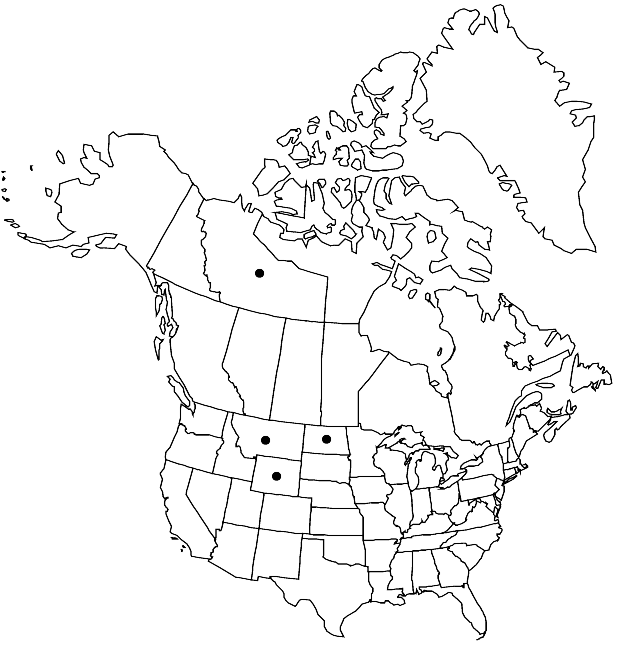Difference between revisions of "Rorippa calycina"
Mem. New York Bot. Gard. 1: 175. 1900.
RevisionBot (talk | contribs) m (Bot: Adding category Revised Since Print) |
RevisionBot (talk | contribs) m (Bot: Adding category Revised Since Print) |
||
| (7 intermediate revisions by 3 users not shown) | |||
| Line 6: | Line 6: | ||
|place=1: 175. 1900 | |place=1: 175. 1900 | ||
|year=1900 | |year=1900 | ||
| + | }} | ||
| + | |special_status={{Treatment/ID/Special_status | ||
| + | |code=E | ||
| + | |label=Endemic | ||
}} | }} | ||
|basionyms={{Treatment/ID/Basionym | |basionyms={{Treatment/ID/Basionym | ||
|name=Nasturtium calycinum | |name=Nasturtium calycinum | ||
|authority=Engelmann ex Hayden | |authority=Engelmann ex Hayden | ||
| + | |rank=species | ||
|publication_title=in G. K. Warren, Prelim. Rep. Expl. Nebraska Dakota, | |publication_title=in G. K. Warren, Prelim. Rep. Expl. Nebraska Dakota, | ||
|publication_place=156. 1859 | |publication_place=156. 1859 | ||
| Line 16: | Line 21: | ||
|name=Nasturtium sinuatum var. calycinum | |name=Nasturtium sinuatum var. calycinum | ||
|authority=(Engelmann ex Hayden) S. Watson | |authority=(Engelmann ex Hayden) S. Watson | ||
| + | |rank=variety | ||
}} {{Treatment/ID/Synonym | }} {{Treatment/ID/Synonym | ||
|name=Nasturtium sinuatum var. pubescens | |name=Nasturtium sinuatum var. pubescens | ||
|authority=S. Watson | |authority=S. Watson | ||
| + | |rank=variety | ||
}} {{Treatment/ID/Synonym | }} {{Treatment/ID/Synonym | ||
|name=Radicula calycina | |name=Radicula calycina | ||
|authority=(Nuttall) Hitchcock | |authority=(Nuttall) Hitchcock | ||
| + | |rank=species | ||
}} {{Treatment/ID/Synonym | }} {{Treatment/ID/Synonym | ||
|name=Rorippa sinuata var. pubescens | |name=Rorippa sinuata var. pubescens | ||
|authority=(S. Watson) Howell | |authority=(S. Watson) Howell | ||
| + | |rank=variety | ||
}} | }} | ||
|hierarchy=Brassicaceae;Brassicaceae tribe Cardamineae;Rorippa;Rorippa calycina | |hierarchy=Brassicaceae;Brassicaceae tribe Cardamineae;Rorippa;Rorippa calycina | ||
| Line 49: | Line 58: | ||
-->{{#Taxon: | -->{{#Taxon: | ||
name=Rorippa calycina | name=Rorippa calycina | ||
| − | |||
|authority=(Engelmann ex Hayden) Rydberg | |authority=(Engelmann ex Hayden) Rydberg | ||
|rank=species | |rank=species | ||
| Line 63: | Line 71: | ||
|publication title=Mem. New York Bot. Gard. | |publication title=Mem. New York Bot. Gard. | ||
|publication year=1900 | |publication year=1900 | ||
| − | |special status= | + | |special status=Endemic |
| − | |source xml=https:// | + | |source xml=https://bitbucket.org/aafc-mbb/fna-data-curation/src/2e0870ddd59836b60bcf96646a41e87ea5a5943a/coarse_grained_fna_xml/V7/V7_773.xml |
|tribe=Brassicaceae tribe Cardamineae | |tribe=Brassicaceae tribe Cardamineae | ||
|genus=Rorippa | |genus=Rorippa | ||
Latest revision as of 19:34, 6 November 2020
Perennials; (terrestrial or of wet habitat, not submerged); densely hirsute throughout, (trichomes pointed, expanded basally). Stems (simple or few from base), erect to prostrate, branched distally, 1–4 dm. Basal leaves not rosulate; blade margins sinuate. Cauline leaves sessile; blade oblong to oblanceolate (lateral lobes oblong to ovate), 2.5–5.5(–7) cm × 5–13 mm, base auriculate to amplexicaul, margins sinuate. Racemes elongated. Fruiting pedicels ascending to suberect, (somewhat appressed to rachis), straight or curved, 2–5(–6) mm (glabrous or sparsely hirsute). Flowers: sepals (persistent after anthesis), ascending, oblong-ovate, 2–3.3 × 0.7–1.3 mm; petals yellow, oblanceolate, (2.2–)2.5–3.7 × 0.7–1.4 mm; median filaments 1.8–2.2 mm; anthers oblong, 0.5–0.6 mm. Fruits silicles, straight, globose or broadly oblong, 2–4 × 1.5–2.5 mm; valves short-strigose; ovules 30–44 per ovary; style 1–2.5 mm. Seeds biseriate, yellowish, ovoid, 0.6–0.7 mm (0.4–0.6 mm diam.), colliculate. 2n = 16.
Phenology: Flowering May–Aug.
Habitat: Stream edges, sandy riverbanks, reservoir, pond, and lake margins
Elevation: 1000-2000 m
Distribution

N.W.T., Mont., N.Dak., Wyo.
Discussion
G. A. Mulligan and A. E. Porsild (1966) reported Rorippa calycina from Northwest Territories and suggested that it may have been introduced to Canada from the main species range in the United States about 4000 km south.
Selected References
None.